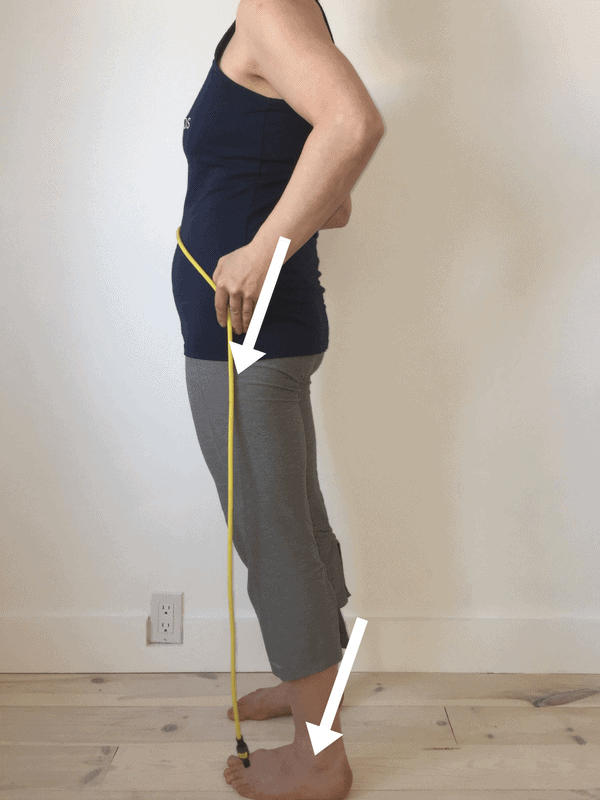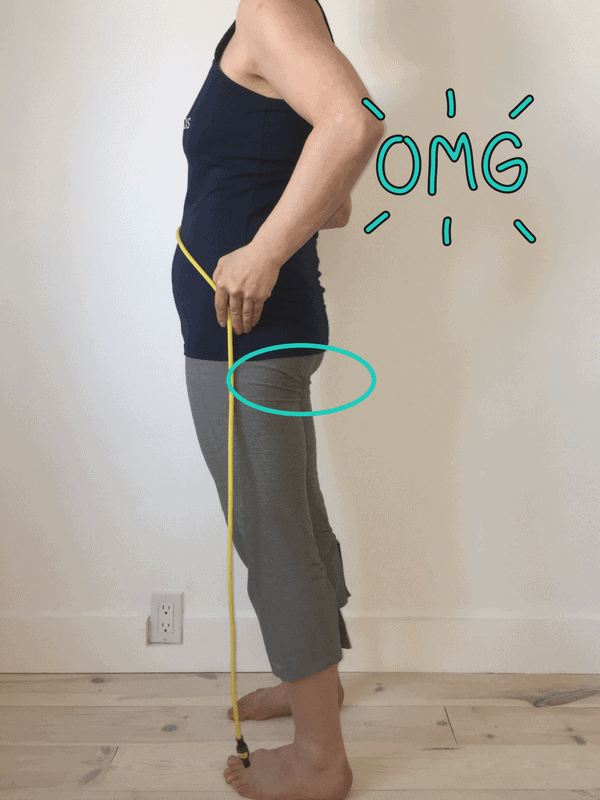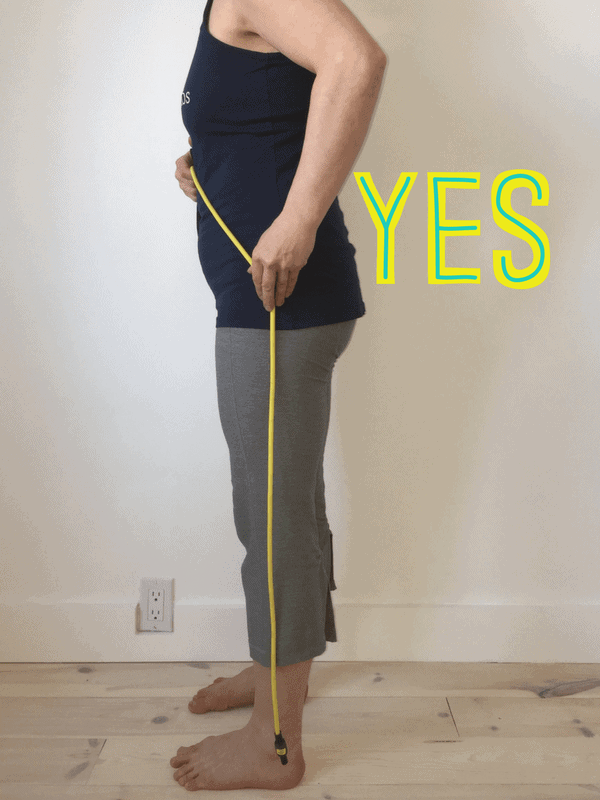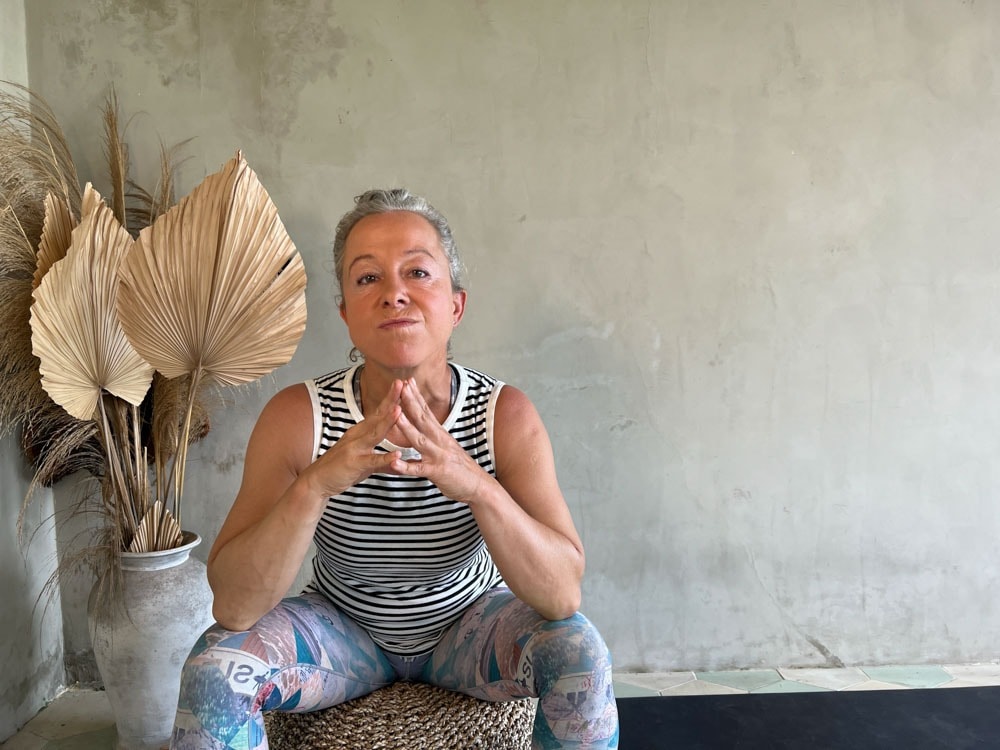I often wish we were taught how to move better in gym class, instead of how to play volleyball. ‘Cause I have literally played volleyball 4 times since high school, but I move every single day.
And I also watch other people moving every single day.
Which means I see soooooo many people making this one particular movement mistake that has major whole-body impacts.
It damages your feet, weakens your pelvic floor, and compresses your lower back. Probably other stuff too.
Today, I’m going to show you what it is and how you can change it.
Is Your Pelvis Too Far Forward?
The problem is simple to explain – almost everyone I see stands with their pelvis pushed way forward.
Instead of our hip joints lining up vertically with the side of our ankles, our hip joints are way out over our feet
Here’s a picture. See how my hips are way forward of my ankles?

So Why Is Pelvic Position A Big Deal?
This isn’t just a big deal. It’s a huge deal. It creates all kinds of wonky issues from the ground up. Here’s a few of them.
Pelvis-forward alignment overloads your feet.
Standing with your pelvis out in front of you seriously overloads your feet. Instead of your weight being held in your big, beefy heel bones, your weight transfers into your smaller forefoot bones and muscles. They have to work double time to hold you – which isn’t really their job.
The result? Overloading the forefoot contributes to foot issues like plantar fasciitis, flat feet, neuromas, and reduced foot mobility and function. And let me just say here, I was a big pelvis-forward-person before I learned better, and I had plantar fasciitis and frequent foot numbness. All gone now!
Take a second to try this yourself. Stand up in bare feet. Notice where your weight is being held (maybe close your eyes, it can help you to feel more stuff). Now, push your pelvis forward. Can you feel how your weight moves into your toes? Then, push your pelvis back until it feels like your heel bones are holding you up. Try that a few times so you can really get a sense of the difference.
Pelvis-forward alignment weakens your pelvic floor.
Standing with your pelvis forward is a major problem for your pelvic floor muscles. In this position, your pelvic floor muscles are constantly held in a short position. Over time, this leads them to adapt, actually becoming shorter and tighter. And that means they become weak, and prone to fail when you sneeze, bounce or have a baby.
Here’s my picture again – check out the wrinkles in my pants right under my butt. That’s basically what happens to your pelvic floor when you stand this way.

Pelvic-forward alignment compresses your low back.
With your pelvis way out in front, you’ve gotta do something so you don’t fall over.
And that probably means you’re going to have to lean back with your ribs and shoulders.
Now you’re shaped kind of like the letter ‘C’, and sadly, your lower back is right in the middle of that ‘C’, getting all short and jammed up.
I’ve been playing around a lot with this position while writing, and boy, do I ever notice it in my back when I push my pelvis forward! You can give it a go yourself – same thing as above. Let your pelvis drift all the way forward so you can feel all your weight in your toes. But this time check in with the sensation in your low back. You can also put your hands on your low back as you push forward – you’ll likely feel the entire area get shorter, and your shirt wrinkle up under your fingers. Yowza!
Why Do We Even Stand With Pelvis Forward Alignment?
Good question. Probably because we learned to play volleyball in school instead of how to move better!
Just kidding. I suspect the culprits here are lots of sitting + wearing shoes with heels (which push us forward all by themselves). Lots of sitting means our butts and hamstrings – which are supposed to help hold us up – get weak. It’s easier just to launch our pelvises forward and let our ligaments, quads and psoas muscles hold us up instead. Too bad it ends up wreaking havoc!
So Where Should My Pelvis Be When I Stand?
It’s pretty simple to fix this problem – you need to start standing with your hips aligned vertically over your heels. That will put your pelvis into a fairly centered position which will help rebalance the muscles that surround your pelvis – like your hips, glutes & pelvic floor – and take a bit of load off your spine & feet.
Like this picture. Notice the difference in the wrinkles in my pants under my butt!

What If I Have Anterior Pelvic Tilt?
So in my experience, most people who’ve been told they have anterior pelvic tilt actually have a combination of pelvis-forward and ribs-lifted. This looks a LOT like anterior pelvic tilt but it’s technically a sneaky posterior pelvic tilt.
I’d start by checking in with what happens when you stand hips-over-heels and drop your ribs (like I share in me free Ribcage Magic video series) and then let me know what you discover!
Here’s How To Get Hips-Over-Heels Alignment
The easy way to find better hips-over-heels alignment? Just push your pelvis back until you feel the weight move out of your forefoot and into your heels. Can you wiggle your toes easily? If so, you’re 90% of the way there. Maybe 100%!
But, I know that learning body stuff from text and images can be a challenge, so here’s a video on how you can find better hips-over-heels alignment.
What If Hips-Over-Heels Alignment Doesn’t Feel Good?
Nothing’s ever simple, is it?
Many of my students find that moving their pelvis all the way back actually creates a lot of tension in their bodies. They feel like they’re going to fall over, and often the fronts of their thighs get really tight to help hold them up. That’s not really the goal.
When we’ve adapted to being forward for a long time, our bodies aren’t always ready to get all the way back.
If this is you, my suggestion is just to work at it slowly. Move as far back as you can without creating tension, and then when you adapt, move a bit further back.
Exercises help too – that’s why I teach them! My Take10 online coaching program has all my favourite exercises to help improve your standing alignment (plus a whole lot more).
P.S. A Major Tip On Getting Your Pelvis Back Where It Belongs
You can’t get your pelvis back if you’re wearing shoes with heels. It’s just not possible.
So if you’re serious about your pelvic floor and your low back, you need to start with your feet by transitioning to zero drop footwear!
Here’s a post I wrote with lots of tips on transitioning, and I also have a free foot course that includes a key exercise to help with hip alignment. Since the position of your hips greatly affects your feet and so much more, this exercise is a game-changer. Sign up for my free Free Your Feet course now and get started on improving your pelvic floor, back, knees and feet TODAY!





